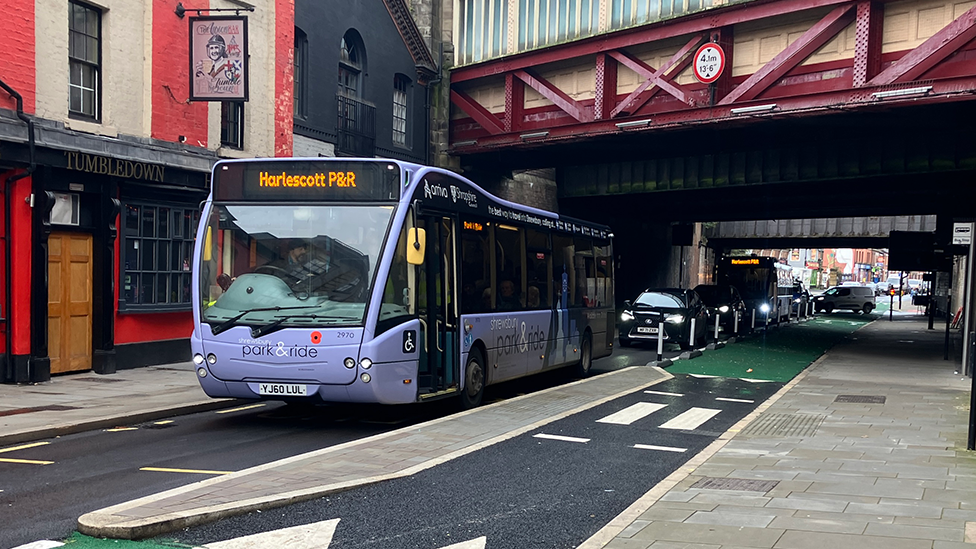Gyratory bus stop does not meet guidelines, BBC finds

The cycle lane separates the main pavement from the 1.1m-wide bus stop waiting area
- Published
A new so-called "floating bus stop" built last month outside a railway station does not meet national standards, according to BBC analysis.
The waiting area for bus passengers in Shrewsbury, Shropshire, is narrower than the minimum size recommended by the Department for Transport (DfT) guidance issued in 2020.
The bus stop, branded dangerous by motorists and disability campaigners, was designed according to a type of floating bus stop that the government put on hold earlier this year due to safety concerns.
Shropshire Council's transport consultant, WSP, said the island ended up smaller than planned because workers found unexpected underground utilities that forced a change in the design.
The BBC measured the buffer area between the road and cycle lane at about 1.1m wide.
However, government guidance suggests, external it should be between 1.5m and 2m, meaning it is nearly 40cm short of the minimum width.
Disability campaigners and wheelchair users have criticised the project, claiming the island is dangerously small and not-fit-for-purpose.

Marcus Watkins is concerned by the speed at which some cyclists may travel through the area
"This could be quite dangerous for somebody in a wheelchair or with limited mobility," said Marcus Watkins, a motor wheelchair user from Shrewsbury.
"The actual bus stop area is a bit peculiar because a bus ramp for a wheelchair would go into the cycle lane.
"There is a pedestrian crossing across the cycle lane, but I've seen this in London where people [cyclists] don't stop, they just sail through," he added.
"So my concern is the safety of people exiting and entering the buses."
WSP, said the design was a "bus stop boarder," which the DfT had advised against using in April because it placed bus passengers and cyclists too close together.
However, the guidance is voluntary, so the local authority is not legally required to follow it.
The National Federation of the Blind of the UK has described the final design in Shrewsbury as discriminatory and wants it scrapped.

Sarah Leadbetter is campaigning for all floating bus stops to be scrapped
"I've got a 32 kilo golden retriever [guide dog], and when she's got her front paws on the bus, I'll be standing in the cycle lane because the island is too narrow," said Sarah Leadbetter, who is registered blind and campaigns for the charity.
"I've got no peripheral vision, so I wouldn't know if cyclists are coming at speed. And if a bike was to hit my guide dog Nellie, then she would be unable to work and that's my mobility gone."
In response to a request from the BBC, WSP said uncharted utilities were discovered during construction, which prevented the design being implemented.
In a statement, the firm added, "Several options were considered and discussed by the project Steering Group. The preferred option reduced the buffer area to 1.2m, from the designed 1.5m as it was deemed better to have a slightly reduced buffer width, than to remove the buffer completely."
There has been widespread dismay at the floating bus stop since it was installed last month and thousands of people have signed a petition to have it removed.
A cross-party Shropshire Council committee will begin an investigation into the entire project later this week.
Its findings and any recommendations will likely be presented to the council in the Spring.
The gyratory project, which began in June 2024, has cost about £3.8m.
It has been almost entirely funded by a Levelling Up grant awarded to Shropshire Council by the previous Conservative government in 2023.
Get in touch
Tell us which stories we should cover in Shropshire
Follow BBC Shropshire on BBC Sounds, Facebook, external, X, external and Instagram, external.
Related topics
- Published21 October

- Published18 October

- Published29 June
